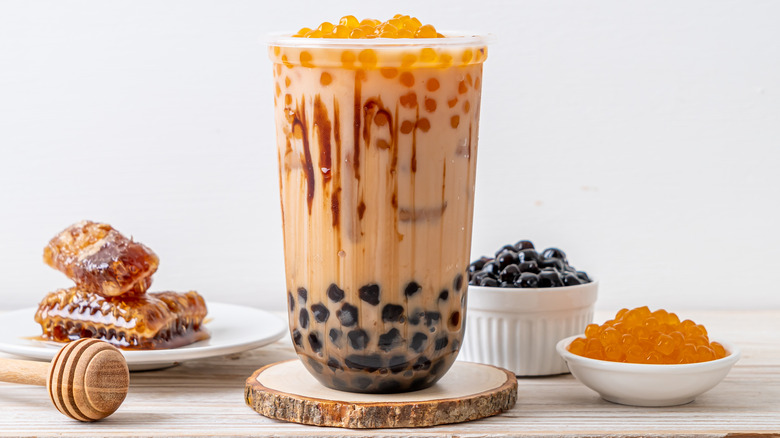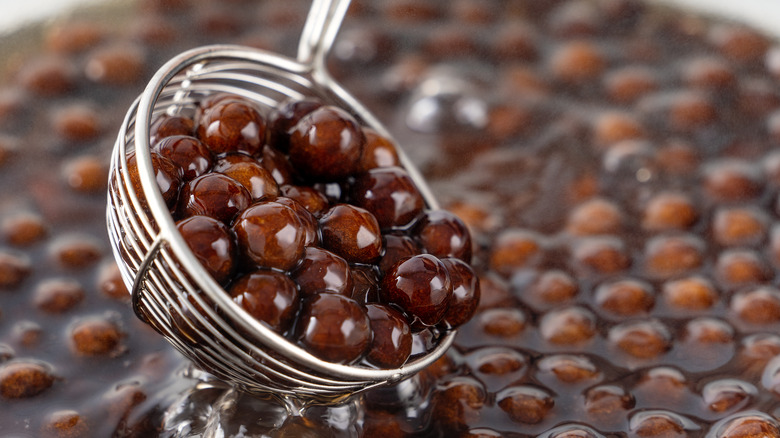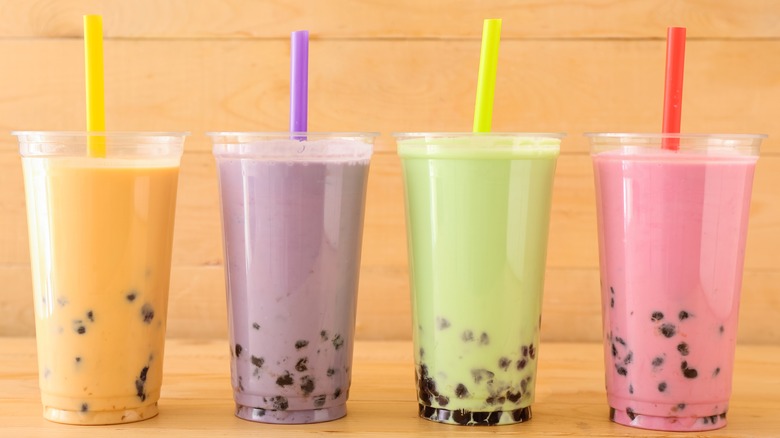Is Sago The Same Thing As Boba?
When you're looking to hydrate but also give yourself a little treat, what's your weapon of choice? Many people prefer coffee or soda: Coca-Cola reports that nearly two billion servings of Coke are consumed each day, while the British Coffee Association says that people enjoy two billion daily cups of the dark and sultry magic we call java. However, it's a humble beverage traditionally made of leaves steamed in hot water that reigns as the most popular drink worldwide: Tea wins the title at a staggering six billion cups enjoyed every day according to National Geographic.
But tea has become more than a steeped bag or loose leaves. In the 20th century, a chilled Taiwanese "bubble" tea colloquially called boba swept across the U.S. Boba tea can be made with any number of ingredients, including fruit juice, egg pudding, and fruit pieces, but it is most often a chilled black tea with milk and tapioca "pearls" served with a special straw capable of sucking up those pillowy, chewy bubbles, per Eater — which is a big part of the fun. However, the barista master behind Full Coffee Roast explains that the tapioca that traditionally makes up boba pearls is sometimes marketed as a different starchy Southeast Asian staple called sago, which begs the question: Is sago the same thing as the famous tapioca boba?
What's the deal with tapioca and sago?
Traditional Taiwanese boba tea calls for tea, milk, ice, and tapioca "pearls," according to Food & Wine. There are a massive amount of bubble tea combinations and toppings available, but the traditional pearls are made from tiny balls of tapioca which are boiled and then marinated at length in a sweet syrup.
Tapioca is a "starch extracted from the cassava root," per WebMD; sago, on the other hand, is also a starch, but it comes from palm tree stems, says Healthline. Sago pearls need to be soaked for longer to achieve the same chewy consistency, explains the owner of cafe Sippers Neha in India, but can be used in place of tapioca pearls — and her customers enjoy both.
But even if they both come in pearl form and taste equally good, the fact that tapioca is sometimes referred to as sago (for example, by the New Delhi Broadcasting Company's Food section) can bewilder discerning tea drinkers. In fact, tapioca is often marketed as a cost-effective sago imitation, adding to the confusion, says Hot Thai Kitchen. But at the end of the day, can either one claim to be true boba?
What does boba actually mean?
The different nomenclature can seem needlessly perplexing, especially when there is false advertising involved, but the biggest culprit is the word "boba" itself. This word has become a colloquial way of referencing bubble tea (which is also called tapioca tea, boba milk tea, or tapioca pearl tea), but it's also the term for the little balls the drink contains, no matter what those balls consist of. And since, as Tastylicious confirms, "boba" simply refers to the pearls in the beverage, it doesn't actually correspond — and isn't limited — to one particular substance or another. Boba is whatever you make boba pearls with.
So, is sago the same thing as boba? Yes and no. If you're using it in a savory dish like spiced sago or a sweet treat like mango sago pudding, then no, that's not boba. But if you're making chewy little pearls out of sago, putting them in tea, and slurping them through a huge straw, then yes!


